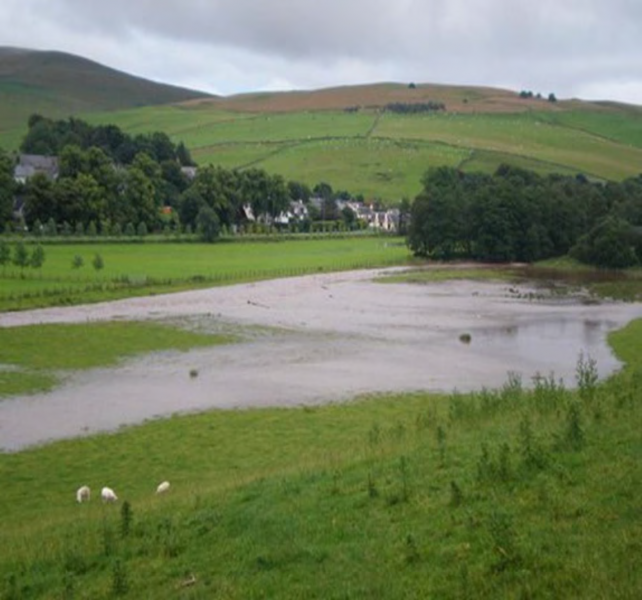Meadows are areas or fields whose main vegetation is grass, or other non-woody plants, used for mowing and haying. Pastures are grassed or wooded areas, moorland or heathland, generally used for grazing. Due to their rooted soils and their permanent cover, meadows and pastures provide good conditions for the uptake and storage of water during temporary floods. They also protect water quality by trapping sediments and assimilating nutrients.
The measure offers the potential for temporary flood storage, increased water retention in the landscape and runoff attenuation. Soil cover is maintained at all times with rooted vegetation, this reduces the surface flow of water and allows greater infiltration to the soil. Rates of soil erosion are considerably lower than arable land with potential benefits for water quality.

Flooded meadow, Scotland (UK)
Source: Chris Spray’s presentation, NWRM Workshop 1 (Scotland)
| Benefits | Level |
|---|---|
|
BP2 - Slow runoff
|
High
|
|
BP5 - Increase evapotranspiration
|
Medium
|
|
BP6 - Increase infiltration and/or groundwater recharge
|
Low
|
|
BP7 - Increase soil water retention
|
Medium
|
|
BP10 - Reduce erosion and/or sediment delivery
|
High
|
|
BP11 - Improve soils
|
Low
|
|
BP17 - Absorb and/or retain CO2
|
Medium
|
|
ES5 - Climate change adaptation and mitigation
|
Medium
|
|
ES6 - Groundwater/aquifer recharge
|
Medium
|
|
ES7 - Flood risk reduction
|
High
|
|
ES8 - Erosion/sediment control
|
High
|
|
ES9 - Filtration of pollutants
|
Medium
|
|
PO3 - Improving status of hydromorphology quality elements
|
Medium
|
|
PO5 - Improving quantitative status
|
Low
|
|
PO7 - Prevent surface water status deterioration
|
Medium
|
|
PO8 - Prevent groundwater status deterioration
|
Low
|
|
PO9 - Take adequate and co-ordinated measures to reduce flood risks
|
High
|
|
PO11 - Better protection for ecosystems and more use of Green Infrastructure
|
High
|
|
PO12 - More sustainable agriculture and forestry
|
Medium
|
|
PO14 - Prevention of biodiversity loss
|
Medium
|
